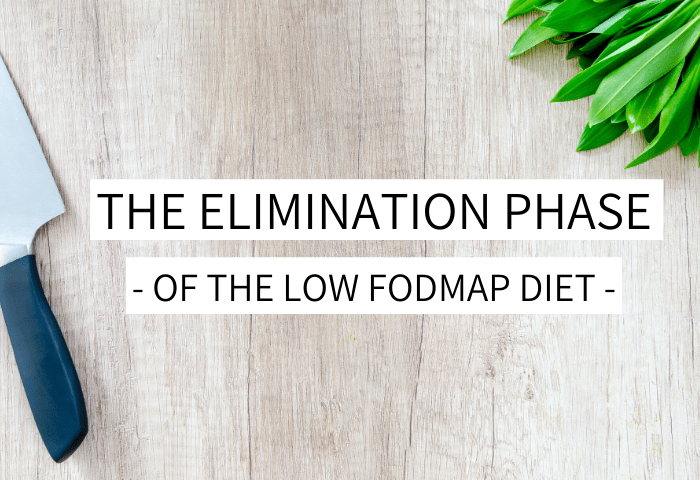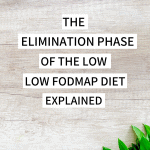
The elimination phase
The elimination phase is the first phase of the low FODMAP diet. In this article, I will explain what this phase is and give you tips and tricks to get through the first weeks smoothly.
What is the FODMAP elimination phase?
The low FODMAP diet has three phases: the elimination phase, the reintroduction phase and the personalisation phase (adapted FODMAP diet). The elimination phase is the phase in which you follow the low FODMAP diet strictly.
The goal of this phase is to get your IBS symptoms under control and reduce them significantly. In the elimination phase, you remove all high FODMAP foods / serving sizes from your diet and only eat foods that are low FODMAP or have a low FODMAP serving size.
This gives you a chance to discover how your body feels when you are not eating high FODMAP foods and to find out if this actually causes a significant change in your symptoms.
How long does the elimination phase take?
The advised length for the elimination phase is two to six weeks. This is the period that most people need to get their symptoms under control.
When your symptoms have significantly decreased, you are ready to start the reintroduction phase and test your reaction on the different FODMAP groups.
Some people find it difficult to start the reintroduction phase because they are scared to get their heavy symptoms back and it feels so good to finally have a calm belly in the elimination phase.
That is very understandable, but I want to tell you that it is really important to start the reintroduction phase when you have your symptoms under control.
The elimination phase of the diet is restrictive and eliminates food groups from your diet that are important for variation in your diet and your gut health in the long-term.
Next to that, if you stay in the elimination phase too long, you are probably unnecessarily restricting foods that you do tolerate. It is great to get some more freedom in the foods you can pick, so why would you keep yourself from being able to do that?

How do I know what I can and cannot eat?
The FODMAP diet has clear guidelines for which foods you can and cannot eat during the elimination phase.
The best resource for learning which foods you can eat and which foods you have to avoid is the Monash University FODMAP app. This app is made by the creators of the low FODMAP diet and is always up-to-date with the latest research.
Here in the Netherlands, dieticians often have booklets too that they can provide. Unfortunately, it often happens that these booklets are outdated and don’t contain the latest information.
The same goes for lists that you can find on the internet. Therefore, I always advise to use the Monash app as your main resource or a booklet that is derived from the Monash app and that has been updated with the latest research.
Ask your dietician when the information in the booklet was last updated. In this blog about the app, you can read all about how the app works.
Tips and tricks for the elimination phase
The first weeks of the low FODMAP diet can be daunting. You have to change your entire way of eating, you are not sure what you can and cannot eat and you have to search a lot in the supermarket. These are my best tips for navigating the elimination phase:
- Start the elimination phase under the guidance of a FODMAP specialised dietician. A dietician with knowledge of the diet can guide your through the first phase, answer all your questions and make sure that you get all the nutrition you need.
- Keep a food- and symptom diary. Keeping a diary in which you write down everything you eat and the symptoms that you have will make it easier to identify when you have made a mistake or what the foods are that trigger symptoms.
It is also handy for your dietician to work with you through the first weeks and to make sure that you get all the necessary nutrients. - Take some time to plan out your meals every week, that will make it easier to follow the diet and not grab something high FODMAP because you are in a hurry. In my recipe index, you can find over 500 low FODMAP recipes for breakfast, lunch, dinner and more.
Almost all recipes are suitable for the elimination phase, if a recipe is not suitable this is always clearly mentioned. - Get some yummy low FODMAP snacks ready, you can find a lot of inspiration here: 80+ low FODMAP snack ideas, low FODMAP snacks to buy in the supermarket and 10 freezer-friendly low FODMAP snacks.
- Join the Karlijn’s Kitchen FODMAP Facebook community. A closed Facebook group where you can ask all your questions about the FODMAP diet and get support from other fodmappers.
Have you finished the elimination phase and are you ready to start reintroducing? Click here to read my blog about the reintroduction phase.
I hope this blog has helped you to feel more confident about starting the elimination phase of the low FODMAP diet. If you have any questions, feel free to ask them below!
Together we go for a calm belly!
Subscribe to the Karlijn's Kitchen e-mail newsletter for more tips and recipes and receive the ebook 10 things I wish I had known when I started the FODMAP diet for free!

